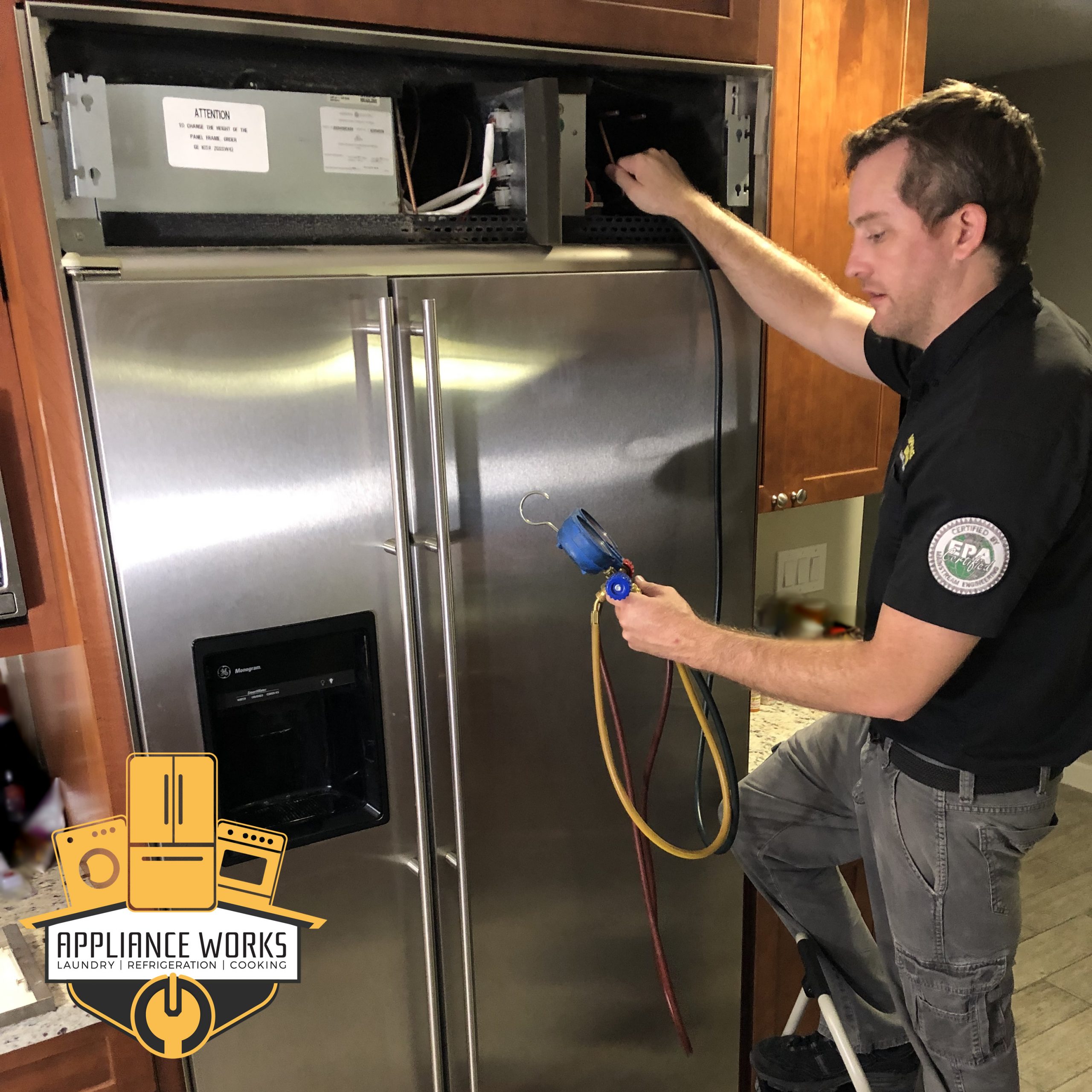Cut Monthly Costs by Fixing Appliance Issues Fast with Dependable Refrigeration & Appliance Repair Service Sub-Zero Appliance Repair
Cut Monthly Costs by Fixing Appliance Issues Fast with Dependable Refrigeration & Appliance Repair Service Sub-Zero Appliance Repair
Blog Article
The Ultimate Guide to DIY Device Repair Work Strategies
From fridges to dishwashers, recognizing just how to repair and fix these gadgets can save you time and money. Are you prepared to find crucial techniques that will empower you to deal with repairs with confidence?
Comprehending Usual Appliance Problems
When you count on your home devices, it can be discouraging when they unexpectedly quit working or act up. Recognizing common appliance troubles can help you fix problems properly. As an example, if your refrigerator isn't cooling, check the temperature level settings or evaluate the door seal for voids. A malfunctioning washing maker could be as a result of a stopped up drainpipe filter or a busted belt.
If your oven isn't heating, faulty components or thermostat concerns could be to criticize,. Dish washers typically experience issues with drain, so ensure the filter is clean and the drainpipe tube isn't kinked.
Additionally, pay attention for uncommon sounds; they typically show mechanical problems. By recognizing these indications, you can save time and possibly avoid expensive repair services. A little understanding goes a lengthy way in keeping your home appliances, so remain notified to maintain whatever running efficiently.
Necessary Tools for DIY Repairs
Prior to diving into DIY home appliance repair services, it is necessary to gather the right tools to ensure the procedure goes smoothly. Beginning with a good set of screwdrivers, including both flathead and Phillips, as they're crucial for opening up most devices. You'll additionally desire a set of pliers for clutching and twisting cables or little components.
Do not forget a multimeter; it aids you examination electric elements and identify issues properly. A socket set is convenient for loosening or tightening up screws, while an utility blade can be useful for reducing cables or opening product packaging.
Lastly, consider having a flashlight on hand to brighten dark areas inside your home appliances. With these essential devices, you'll be well-appointed to deal with numerous fixings, conserving both time and money. Collect your gear and obtain ready to roll up your sleeves!
Safety First: Precautions to Take
Prior to you begin any appliance repair, it's vital to prioritize security. Make sure you use individual safety tools, disconnect the power source, and keep your workspace organized. These easy precautions can assist avoid crashes and assure a smoother repair work process.

Individual Safety Devices
Security equipment is an essential part of any kind of DIY device fixing task. Steel-toed boots are additionally a smart choice, specifically when raising hefty devices. Remember, being prepared with the appropriate equipment keeps you safe and concentrated on finishing your repair work efficiently.
Source Of Power Interference
To assure a safe do it yourself home appliance repair service, detaching the source of power is vital. Before you begin any kind of work, you need to transform or unplug the appliance off the breaker. This easy action prevents electric shocks and assurances that you can concentrate on the repair work without fretting about unintentional activation. Constantly double-check that the appliance is off by examining it with a voltage tester. If you're dealing with bigger home appliances, like a washing machine or dryer, see to it to safeguard the power cable and avoid any type of call with water. Keep in mind, safety and security! Once you're certain that the power is disconnected, you can confidently proceed with your repair services, knowing you have actually taken the necessary precautions to protect on your own.
Job Location Organization
An efficient workplace can make all the difference in your DIY device repair service project. Start by clearing your work space of clutter to prevent accidents and disturbances. Lay out all your products and tools, grouping comparable products with each other for easy gain access to. Make use of a toolbox or coordinator to keep little components like screws and washers had and identified. Ensure you have actually obtained appropriate lights; it'll aid you see details clearly and reduce the risk of blunders. Do not forget to maintain safety gear like gloves and safety glasses available. Have a trash bag handy to dispose of waste without delay. A clean room not just improves effectiveness however also keeps you secure while you service your appliance fixing.
Step-by-Step Guide for Fridge Repair Works
When your fridge begins acting up, it can be frustrating, but tackling the problem yourself can conserve you time and cash. Inspect for common problems like temperature level changes or unusual noises. For a loud refrigerator, inspect the fan and validate it's not blocked.
If there's water merging inside, evaluate the door seals for damages or dust, and tidy them if necessary. For ice buildup, clear the defrost drainpipe. Once you've resolved the problem, connect the fridge back in and check it for a couple of hours. If the issue persists, you might require to change a defective component, like the compressor or fan motor. Keep in mind, don't be reluctant to speak with the manual or seek professional help if needed.
Fixing Washing Machine Problems
Just like fridges, washing equipments can provide their very own collection of challenges, but several concerns can be solved with a little bit of troubleshooting. If your equipment won't start, check the power cord and validate it's connected in. Next, evaluate the door lock; a damaged lock can protect against the cycle from beginning. If you observe uncommon sounds during procedure, it might be as a result of international items stuck in the drum or the drain pump.
If your clothes aren't getting clean, think about the click now water level and cleaning agent type; utilizing excessive detergent can produce excess suds, influencing efficiency. For leakages, analyze the tubes for fractures or loosened links. Tightening up these can frequently resolve the problem. Regular upkeep, like cleansing the filter, can protect against many problems from arising. Keep in mind, a little troubleshooting goes a long method in maintaining your cleaning machine running smoothly.
Fixing Stoves and Ovens
How can you fix common concerns with your stove or stove? Begin by checking the power supply. Make certain it's connected in and the breaker is not stumbled. If it's a gas cooktop, confirm the gas shutoff is open. Next off, examination the burners: if they do not stir up, clean up the igniter and check for clogs in the heater ports.
If your oven isn't heating, evaluate the temperature settings and confirm the door seals tightly. A faulty burner can additionally be the wrongdoer; you may require to change it if it's damaged.
For irregular food preparation, rotate your frying pans and take into consideration making use of an oven thermostat to validate accurate temperatures. If you listen to uncommon sounds or smell gas, transform off the home appliance right away and seek advice from a professional. By following these actions, you can determine and resolve numerous typical oven and oven concerns efficiently.
Fixing Dishwashers Facilitated
When your dish washer starts acting up, it can be aggravating, but dealing with typical problems isn't as difficult as it seems. You'll find out step-by-step troubleshooting techniques that will assist you determine the issue, along with the essential tools you'll need to take on fixings yourself. Allow's make repairing your dish washer a breeze!
Typical Dishwashing Machine Concerns
While dishwashing machines are developed to make your life easier, they can often run into typical concerns that leave you feeling annoyed. One constant trouble is poor cleaning efficiency; this frequently takes place due to clogged up spray arms or unclean filters. You could also discover water pooling near the bottom, which can suggest a kinked hose or a damaged drain. It can be an easy problem with the latch mechanism or door seal if your dishwasher's door will not lock. Furthermore, odd noises can indicate damaged components or loosened parts. If you scent something odd, it may be time to check for food particles or a malfunctioning electric motor. Resolving these problems early can save you time and headache in the future (Dependable Refrigeration & Appliance Repair Service).

Step-by-Step Troubleshooting
Before diving right into repair services, it's important to determine the certain problem your dishwasher is facing. If it's not cleaning correctly, Begin by inspecting. Examine the spray arms for blockages and guarantee they spin easily. If it's dripping, analyze door seals and pipes for any kind of damages. For strange sounds, listen very closely during cycles; international things may be stuck in i loved this the filter or impeller. If your dishwashing machine won't begin, check the power supply and door lock. Don't neglect to consult your customer manual for troubleshooting pointers particular to your model. By methodically attending to each possible concern, you can determine the issue and take the essential actions to fix it, making your dishwasher feature like brand-new again.
Crucial Fixing Devices
Having the right tools available can make all the distinction when repairing your dishwashing machine. Start with a screwdriver collection, as you'll typically require both Phillips and flathead options. A multimeter's vital for detecting electrical problems, while pliers can assist you grasp and adjust various elements. Don't neglect a pail or towels for any water spills throughout repairs.
You might also want a degree to site here ensure your dishwasher's correctly lined up. With these vital tools, you'll be fully equipped to deal with any type of dish washer repair obstacle that comes your method.
Frequently Asked Concerns
If an Appliance Is Well Worth Fixing?, how Do I Identify.
To identify if a device's worth fixing, consider its age, repair service prices, and present worth. If repairs go beyond half the substitute cost, you could wish to purchase a new model rather.
Can I Find Substitute Components In Your Area for My Home Appliance?
Yes, you can commonly find replacement components in your area for your appliance. Inspect hardware shops, device repair work stores, or local classifieds. Don't forget to bring the version number to assure you get the appropriate part!
What Typical Mistakes Should I Avoid When Repairing Devices?
When fixing home appliances, avoid hurrying with diagnostics, neglecting safety preventative measures, or using wrong tools. Don't skip checking out guidebooks or viewing tutorials; they provide vital support. Hold your horses and extensive to ensure successful fixings and avoid more damages.
How Lengthy Does a Regular DIY Home Appliance Fixing Take?
A normal DIY home appliance repair work normally takes one to three hours, relying on the intricacy. You'll wish to collect your tools and products first, and follow instructions meticulously to prevent unneeded delays.
Exist Any Type Of Service Warranties for Do It Yourself Appliance Fixes?
When you deal with DIY device fixings, service warranties typically do not cover your work. Some manufacturers could honor guarantees for components you change. Constantly inspect your home appliance's service warranty terms prior to starting any kind of repair work to stay clear of problems.
Prior to diving into Do it yourself home appliance fixings, it's vital to gather the right devices to assure the process goes smoothly.Prior to you start any kind of device repair service, it's necessary to prioritize security.To ensure a safe DIY appliance repair, separating the power source is vital.An efficient work location can make all the distinction in your DIY home appliance repair task. Constantly check your home appliance's service warranty terms before beginning any type of repair services to avoid problems.
Report this page